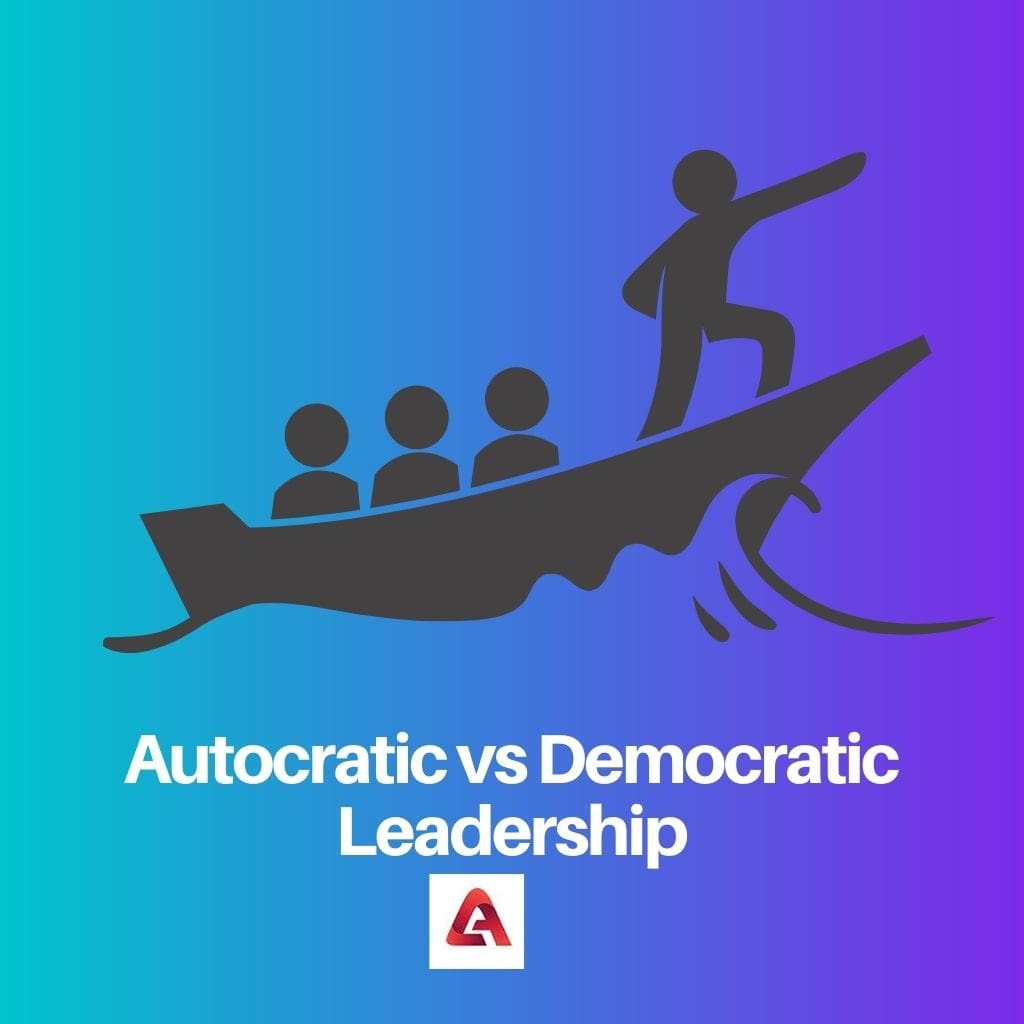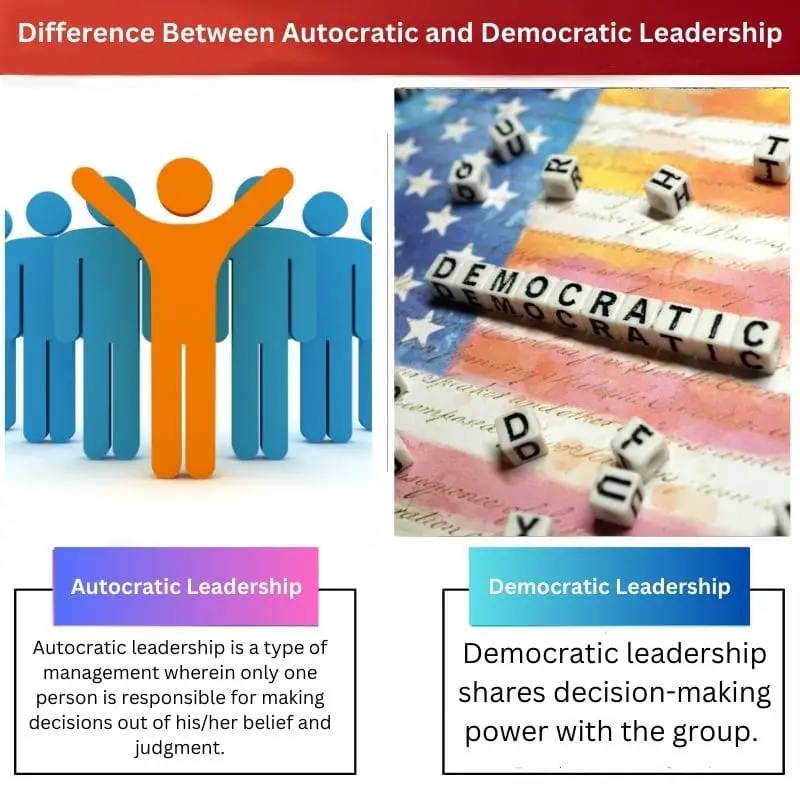Autocratic leadership is characterized by a single, authoritative figure making decisions without much input from others, fostering a hierarchical and centralized approach. In contrast, democratic leadership involves collective decision-making, where input from team members is valued, promoting a more inclusive and participatory environment.
Key Takeaways
- Autocratic leadership is centralized and authoritarian, while democratic leadership is participatory and inclusive.
- Autocratic leaders make decisions independently and impose them on others, while democratic leaders involve their team members in decision-making.
- Autocratic leadership is helpful in emergencies or situations that require quick action, while democratic leadership fosters teamwork and innovation.
Autocratic vs Democratic Leadership
The difference between Autocratic and Democratic Leadership is the authority they proceed. Autocratic leadership is centralized. Whereas the democratic is precisely the opposite, it is decentralized. The autocratic has a high level of control over the subordinates. Conversely, democratic leadership has less command as compared to the former. The followers of the autocrats are obedient, uneducated, and unskilled. On the other side, followers of democrats are professional and experienced.

Comparison Table
| Feature | Autocratic Leadership | Democratic Leadership |
|---|---|---|
| Decision-Making | Leader makes all decisions | Leader consults with team members and seeks their input before making decisions. |
| Authority | Leader holds all authority and power | Authority and power are shared between the leader and team members. |
| Communication | One-way communication from leader to team members | Two-way communication between leader and team members. |
| Motivation | Driven by fear of punishment or rewards | Driven by intrinsic motivation, sense of ownership, and personal growth. |
| Creativity and Innovation | Limited due to lack of input and risk-taking | Encouraged by open communication and diverse perspectives. |
| Flexibility and Adaptability | Slow to adapt to change due to centralized decision-making | More flexible and adaptable due to shared decision-making and diverse perspectives. |
| Team Morale and Engagement | Often low due to lack of autonomy and control | Can be high due to involvement and shared responsibility. |
| Leadership Development | Limited opportunities for team members to develop leadership skills | Opportunities for team members to develop leadership skills and take on more responsibility. |
| Best suited for: | Crisis situations, clear goals, and routine tasks | Complex situations requiring creativity, innovation, and adaptability. |
What is Autocratic Leadership?
Autocratic leadership is characterized by a single leader or a small group of leaders who make decisions with little or no input from subordinates. In this leadership style, the leader retains significant control over decision-making, setting goals, and directing the team without seeking much input from team members. Autocratic leaders make decisions based on their own beliefs, experiences, and judgment, and they expect subordinates to comply with their directives without much discussion or debate.
characteristics of autocratic leadership
1. Centralized Decision-Making: Autocratic leaders centralize decision-making authority within themselves. They are the primary source of direction, and decisions flow downward from the leader to the team.
2. Limited Input from Team Members: Subordinates have minimal involvement in the decision-making process. Autocratic leaders may not actively seek input or feedback from their team members, and decisions are made unilaterally.
3. Clear Hierarchy and Chain of Command: Autocratic leadership relies on a clear hierarchical structure and a well-defined chain of command. The leader gives orders, and subordinates are expected to follow them without question.
4. Quick Decision-Making: Autocratic leaders are known for making quick decisions. The absence of lengthy consultations or discussions allows for swift action, which can be advantageous in certain situations.
5. Authoritarian Control: Autocratic leadership tends to involve a strong element of control and authority. The leader sets expectations and enforces compliance, and deviations from the established norms may be met with strict consequences.
6. Limited Creativity and Innovation: The lack of collaboration and input from team members may stifle creativity and innovation. The organisation may miss out on diverse perspectives since subordinates have little room for expressing their ideas.
7. Effective in Crisis Situations: Autocratic leadership can be effective in crisis situations or when quick, decisive action is necessary. The leader’s ability to make rapid decisions without extensive consultation can be critical in emergencies.
Advantages of Autocratic Leadership
- Efficiency: Autocratic leadership can facilitate quick decision-making and task execution, leading to greater efficiency in certain situations.
- Clarity: Clear hierarchy and direction provided by autocratic leaders can reduce ambiguity and confusion among team members.
- Effective in Crisis: In times of crisis or emergencies, autocratic leadership can be effective in providing swift direction and coordination.
Challenges of Autocratic Leadership
- Lack of Creativity: Limited input from team members may result in missed opportunities for innovation and creative problem-solving.
- Low Morale: Autocratic leadership can lead to feelings of resentment and disengagement among team members who feel marginalized or undervalued.
- Dependency: Overreliance on the leader for decision-making can hinder the development of independent thinking and problem-solving skills among team members.

What is Democratic Leadership?
Democratic leadership, also known as participative or shared leadership, is a style of leadership that encourages the active participation of team members in decision-making processes. This approach values all members’ input and fosters an organisation’s collaborative and inclusive environment. Unlike autocratic leadership, where a single authority figure makes decisions, democratic leadership distributes decision-making responsibilities across the team. This leadership style is rooted in the principles of democracy, aiming to ensure that everyone has a voice and that decisions reflect the collective wisdom of the group.
Characteristics of Democratic Leadership
- Inclusivity:
- Democratic leaders involve team members in the decision-making process. They seek input, opinions, and ideas from individuals at various organisational levels.
- Collaboration:
- Collaboration is a key aspect of democratic leadership. Team members are encouraged to work together, share their expertise, and contribute to the overall success of the team or project.
- Open Communication:
- Transparent and open communication is vital in a democratic leadership style. Leaders provide information, share the reasoning behind decisions, and create an atmosphere where individuals feel comfortable expressing their thoughts.
- Shared Responsibility:
- Responsibility for decision-making is shared among team members. This promotes a sense of ownership and leverages the group’s diverse skills and perspectives.
Advantages of Democratic Leadership
- Increased Motivation:
- By involving team members in decision-making, democratic leaders can boost motivation and engagement. Individuals feel empowered and more likely to commit to the organisation’s goals.
- Enhanced Creativity:
- The diverse input from team members leads to more creative and innovative solutions. Different perspectives contribute to a richer pool of ideas and potential solutions to challenges.
- Improved Problem-Solving:
- The collective intelligence of the team enhances problem-solving capabilities. Issues are addressed with broader insights, making the decision-making process more robust.
- Higher Job Satisfaction:
- Employees working under democratic leadership experience higher job satisfaction. This is attributed to their involvement in decision-making, feeling valued, and having control over their work.
Challenges of Democratic Leadership
- Time-Consuming:
- The democratic decision-making process can be time-consuming, especially when consensus is sought. This may not be suitable for situations requiring quick and decisive action.
- Potential for Conflict:
- Involving multiple perspectives may lead to conflicts within the team. Effective communication and conflict resolution skills are crucial for a democratic leader to manage such situations.
- Not Always Applicable:
- While democratic leadership is effective in many situations, there are instances, such as emergencies or crises, where a more autocratic or directive approach may be necessary.

Main Differences Between Autocratic and Democratic Leadership
- Decision-making Process:
- Autocratic leadership involves centralized decision-making, where the leader holds sole authority and makes decisions without input from others.
- Democratic leadership encourages participation from group members, allowing them to contribute ideas and opinions before decisions are made.
- Power Distribution:
- In autocratic leadership, power is concentrated in the hands of the leader, who dictates rules, procedures, and tasks.
- Democratic leadership disperses power among group members, fostering a collaborative environment where authority is shared.
- Communication Style:
- Autocratic leaders communicate directives in a top-down manner, expecting compliance from subordinates without much discussion.
- Democratic leaders promote open communication and dialogue, encouraging active listening and constructive feedback among team members.
- Motivation and Engagement:
- Autocratic leadership may lead to lower levels of motivation and engagement among team members due to limited autonomy and participation.
- Democratic leadership tends to enhance motivation and engagement by involving individuals in decision-making processes, thereby fostering a sense of ownership and accountability.




